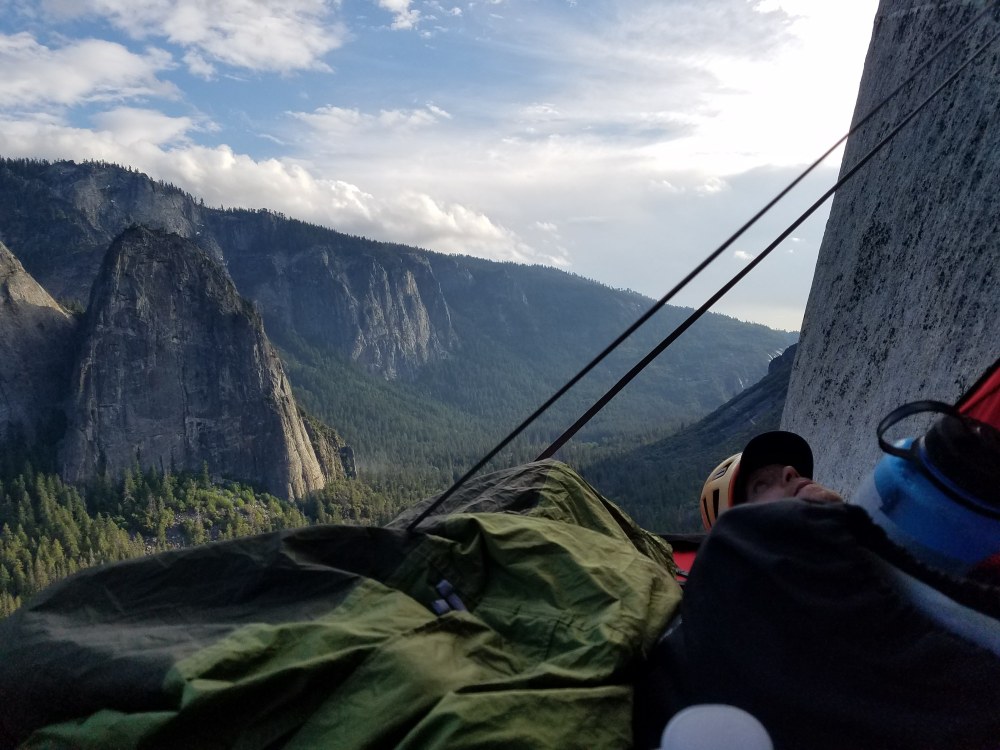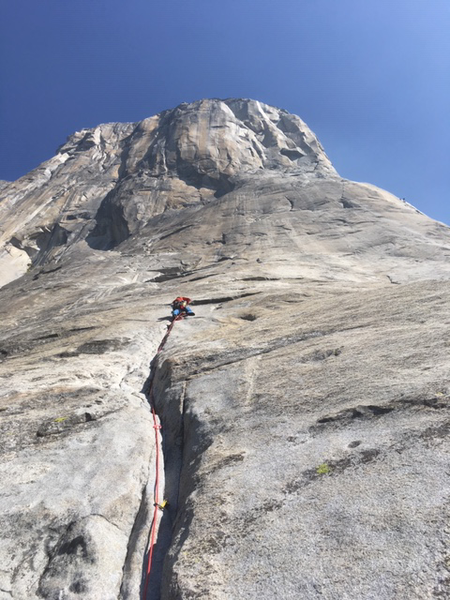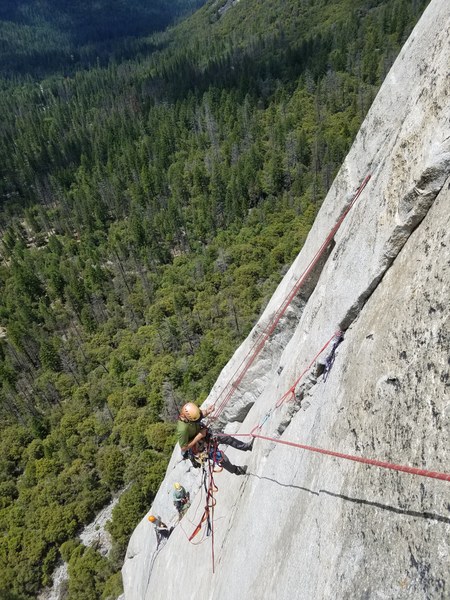
In the past several years, climbing El Capitan in Yosemite National Park has blown up in the mainstream consciousness. With Free Solo winning an Oscar and the Dawn Wall ascent getting publicized in The New York Times, it seems as if everyone has a clear picture of what climbing El Cap is like. It is easy to imagine being up on the side of the wall when you see it on a high definition movie theater screen. But is it as easy as people make it look?
As a passionate rock climber based in the Northwest, I have worked my way up from bouldering, to sport climbing, and finally to traditional climbing. I cut my teeth on Cascade classics like the North Ridge of Stuart, Prusik Peak, Liberty Bell, and multi pitch routes at the Index Town Walls. With each climb, I felt like I was building up my climbing resume and was ready for a bigger challenge.
The holy grail of rock climbing, particularly as it’s portrayed in climbing media, is El Capitan. I‘ve long had it in my head that I, too, would climb El Cap someday. I was so confident that the ascent was completed in my mind before even setting out.
The Salathe Wall
In 2017 I met up with a friend from Utah to climb the Salathe Wall, a 35-pitch grade VI aid climb on El Cap. I had zero previous experience on a big wall, having led two pitches of aid, jugged a few lines, and never hauled a haul bag. As Ross had already successfully climbed El Cap, I was confident that under his leadership we would get up the route.

Blasting off on the Salathe route. Photo by David Gladish.
I quickly realized that climbing a big wall is much different than climbing a standard multipitch climb. I was certainly capable; I managed to lead, jug, and haul, but I was so overwhelmed by the compilation of new skills, the constant exposure, and the thought of being on the wall for several days without touching ground. It was too much for me, and we bailed after one night and 12 pitches. I might have chosen to see this as a good first effort and a positive learning experience, but instead I was crushed. I felt like a failure and was embarrassed that so many other climbers I knew had completed the climb when I bailed. I left the Valley determined to come back again.
The Nose
In 2019 stars aligned, and I was back to Yosemite. This time I took my training more seriously. I spent time at the aid climbing practice area at The Mountaineers facility honing my aid climbing skills. Having a dedicated space to train such specific skills was a game changer for me. I completed a few classic aid lines at Index and slept in a portaledge for several nights. I once again began to experience the familiar feeling of “knowing” I could reach the summit of El Cap if I showed up to Yosemite; it was all but in the bag.
We set our sights on The Nose. I had a new climbing partner, new strategies, and more experience. The plan was to spend three or four nights on the wall, depending on how fast we were climbing. Day one went smoothly. Our haul bags were too heavy, and we were tested with new maneuvers we’d never done on real rock, but we set up our portaledge feeling like we’d made good progress.
As dusk came and we settled into our bivy, my anxiety began to build. It was easy to be distracted by tasks during the day, but alone in my sleeping bag, perched on the side of the cliff, it dawned on me how high we were off the ground. This was nothing like the exposure I had experienced on alpine climbs in the PNW. This exposure was sheer, and dead vertical. There were no ledges below us to break up the thousand-foot view straight down.
It was hours before I slept.
I woke with a start. Rock, rock, rock!!! I peeled open my eyes just as a massive rock came whizzing by, mere feet from our precarious position. We felt lucky to be alive. What happened to my image of climbers making 5.13 moves on El Capitan big walls with no helmet, dancing up the wall carefree and making it look like cragging at a local cliff? The magazines, podcasts, movies, and Instagram feeds made climbing El Cap seem trivial, so why was I sweating profusely, terrified and feeling in danger for my life?
The next day we woke up to a splitter forecast, the route was not overcrowded, and we had plenty of food and water. But I had made up my mind to go down. I was ready to get the hell off the wall. Finding myself in fight or flight mode, decided to flee. My partner was ready to keep going, and calmly tried to talk me into continuing, but I was having none of it; and so, for the second time in three years, I found myself rappelling down the side of El Cap, bailing on my dream.

Lowering out on the Nose. Photo by Dirk Rogstad.
My perspective changed almost immediately once I was back on solid ground. The instant relief and security of being able to walk around untethered and the freedom of movement quickly outweighed the insecure feelings of being exposed, feeling trapped, and wanting to get down. When I called “off rappel” and disconnected from the rope, back on terra firma, I felt both relief and shame. What was the big deal up there? Why was I so scared? We were being safe, conscious, and calculated, so why was I so eager to get down? In the same moment, I felt both great relief and an eagerness to get back on the climb even though just hours ago I had felt utter fear.
In the few days we had left in Yosemite, we managed to climb the South Face of Washington Column, a “beginner” big wall climb by many standards, but something to be proud of. We spent the night on a bivy ledge big enough to walk around unroped. The climbing was straightforward, the scenery was spectacular, and Dirk and I had a fantastic time together. We marveled at the beauty of Half Dome directly across the Valley. We shared whiskey and stories on our spacious platform. And we enjoyed smooth climbing and Type 1 fun for two glorious days.
Big wall lessons
Climbing in Yosemite and attempting El Capitan built deep connections for me, solidifying my friendships with Ross and Dirk. My partners never ostracized me or harbored negative feelings, even though I was the one that insisted we turn around both times. Instead of being angry about spending their precious vacation time trying and failing to climb El Cap, my partners moved on and focused on other climbs. While I was having a hard time not beating myself up, they were focused on the beauty of our surroundings, the fun climbing we were still able to enjoy, and relaxing in the Camp 4 campground.
It took me quite some time to stop being angry with myself for my decision to bail on El Cap. When I look back on those two trips to Yosemite, I do think about what it was like on the wall and I still have hopes to try again. As I’ve let go of some of the disappointment and self-deprecation of not accomplishing my goal, I have also realized that getting to the top of El Cap was never the real goal. Fostering connections through shared experiences in challenging and high consequence situations are the true rewards. I came away from Yosemite with a new sense that my partners had my back, that climbing is not about the summit, and that my strongest connections are developed through shared experiences in vertical terrain.
This article originally appeared in our Fall 2020 issue of Mountaineer Magazine. To view the original article in magazine form and read more stories from our publication, visit our magazine archive.
 David Gladish
David Gladish